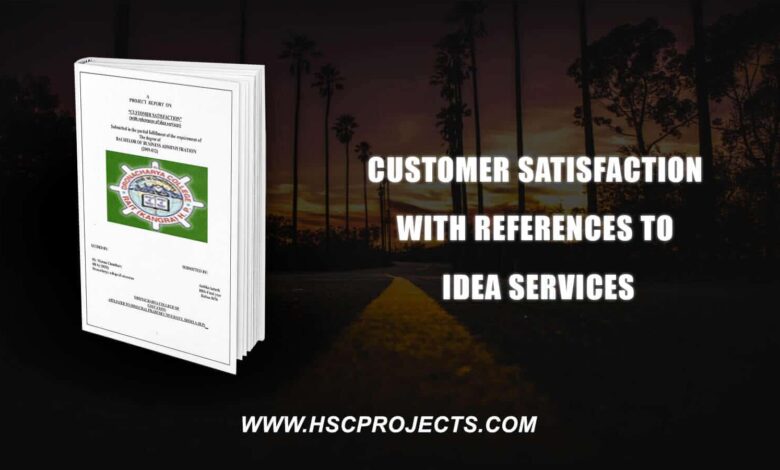
Customer Satisfaction With References to Idea Services
Customer Satisfaction With References to Idea Services
Why Organizations Focus on Customer Satisfaction
Businesses monitor customer satisfaction in order to determine how to increase their customer base, customer loyalty, revenue, profits, market share, and survival. Although greater profit is the primary driver, exemplary businesses focus on the customer and his/her experience with the organization. They work to make their customers happy and see customer satisfaction as the key to survival and profit. Customer satisfaction, in turn, hinges on the quality and effects of their experiences and the goods or services they receive.
Customer Satisfaction
The definition of customer satisfaction has been widely debated as organizations increasingly attempt to measure it. Customer satisfaction can be experienced in a variety of situations and connected to both goods and services. It is a highly personal assessment that is greatly affected by customer expectations. Satisfaction also is based on the customer’s experience of both contacts with the organization (the “moment of truth” as it is called in business literature) and personal outcomes. Some researchers define a satisfied customer within the private sector as “one who receives significant added value” to his/her bottom line—a definition that may apply just as well to public services. Customer satisfaction differs depending on the situation and the product or service. A customer may be satisfied with a product or service, an experience, a purchase decision, a salesperson, store, service provider, or an attribute or any of these. Some researchers completely avoid “satisfaction” as a measurement objective because it is “too fuzzy an idea to serve as a meaningful benchmark.”4 Instead, they focus on the customer’s entire experience with an organization or service contract and the detailed assessment of that experience.
For example, reporting methods developed for health care patient surveys often ask customers to rate their providers and experiences in response to detailed questions such as, “How well did your physicians keep you informed?” These surveys provide “actionable” data that reveal obvious steps for improvement. Customer satisfaction is a highly personal assessment that is greatly influenced by individual expectations
Some definitions are based on the observation that customer satisfaction or dissatisfaction results from either the confirmation or disconfirmation of individual expectations regarding a service or product. To avoid difficulties stemming from the kaleidoscope of customer expectations and differences, some experts urge companies to “concentrate on a goal that’s more closely linked to customer equity.” Instead of asking whether customers are satisfied, they encourage companies to determine how customers hold them accountable Customer satisfaction, a business term, is a measure of how products and services supplied by a company meet or surpass customer expectation. It is seen as a key performance indicator within business
Customer satisfaction depends on the product’s performance relative to a buyer’s expectation, the customer is dissatisfied. If preference matches expectations, the customer is satisfied. If preference is exceeded expectation, the customer is highly satisfied or delighted outstanding marketing insurance companies go out of their way to keep their customer satisfied. Satisfied customers make repeat purchases insurance products and tell others about their good experiences with the product. The key is to match customer expectations with company performance. Smart insurance company’s aim to delight customers by promising only what they can deliver, then delivering more than the promise. Consumers usually face a broad array of products and services that might satisfy a given need. How do they choose among these many marketing makers offers? Consumers make choices based on their perception of the value and satisfaction that various products and services deliver.
Customer value is the difference between the values the customer gains from owning and using a product and the costs of obtaining the products customers from expectations about the value of various marketing offers and buy accordingly. How do buyers from their expectations? Customer expectations are based on past buying experiences, the opinion of friends and marketer and competitor information and promises.
Customer satisfaction with a purchase depends on how well the product’s performance lives up to the customers’ expectations. Customer satisfaction is a key influence on future buying behavior. Satisfied customers buy again and tell others about their good experiences dies-satisfied customer often switches to competitors and disparage the products to others. An insurance provider opens only to active duty, retired and separated military members and their immediate families and therefore not included in the rankings, achieved a satisfaction ranking equal to that any insurance company.
In general, customer satisfaction with auto insurance providers decreased significantly, with 20 of the 21 companies surveyed decreasing satisfaction from the previous year. Insurance is the only carrier that did not experience a decline in satisfaction. Though consumers report their insurance carriers are resolving their claims and problems faster. Businesses survive because they have customers who are willing to buy their products or services. However, many businesses fail to “check in” with their customers to determine whether they are happy or not and what it will make to make or keep them happy.
According to U.S consumers’ affairs department, it costs five times more to gain a new customer than to retain an existing one. Other studies have repeated that with just a five percent increase in Customer retention’s a firm can raise its profitability customers to spend salary at first, but with succeeding years of good experience, they will spend increasingly more.
Depending on the industry and the nature of the bad experience, dissatisfied customers will complain to 10 to 20 friends and acquaintances, which is three times more than those with good experiences are. Hence, the negative information is influential, and consumers generally place significant weight on it when making a decision. If that is not the reason enough, the fierce competitor is needed more and more to differentiate firms from one another. With the technology available to virtually everyone today, the traditional features and cost advantages are no longer relevant. Still product and service quality provides an enormous opportunity to distinguish a firm from the rest. The Japanese have recognized this and have thought us to expect quality. Today’s consumers do, and they know more about products and services than they ever did.
Customers are the best source of information. Whether to improve an existing product or service or whether firms are planning to launch something new. There is no substitution for “getting it from horse’s mouth” When you talk to your customer directly, to increase your odds for achieving the success you “mistake-proof” your decisions and work on what really matters. When you routinely ask the customers for feedback and involve them in business they, in turn, become committed to the success of your business.
PREVIEW
Title – Customer Satisfaction With References to Idea Services
Author – Anitika Katoch
College – Dronacharya College Of Education
In order to download the PDF, You must follow on Youtube. Once done, Click on Submit
Follow On YoutubeSubscribed? Click on Confirm
Download Customer Satisfaction With References to Idea Services PDF






